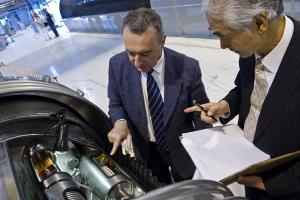A birthday and a visit
27 May 2011
-
Robert Arnoux
Lucio Rossi, Deputy Department Head (Technology) shows DG Motojima the junction of two conductors whose braze (a metal alloy welded joint) failed in the September 2008 experiment. © CERN
Robert Aymar, who headed the ITER Project from 1994 to 2004 and was Director-General of CERN from 2004 to 2008, turned 75 last March. As is traditional at CERN, a celebration was organized in his honour.
Several speakers, CEA Chairman Bernard Bigot, former Director of JET Jean Jacquinot and among them, were invited to retrace the career of the prominent physicist.
Aymar's birthday celebration was also the occasion for CERN to invite ITER Director-General Osamu Motojima to visit the installation for the first time.
CERN and ITER have a lot in common. Both are international collaborations with staff from more than 30 countries; both have faced significant cost increases and have had to implement stringent cost-containment policies; and both are pioneering challenging new technologies, for example in the field of cryogenics.
"There is a feeling of great excitement here," says Jacquinot who accompanied Director-General Motojima in his visit. "A sense of imminent discovery permeates the atmosphere; you can see it in people's eyes."
CERN is presently engaged in the quest of the "Higgs boson," a fundamental particle inferred from theory but that has yet to be observed.
Collaboration between the European institution and the world of fusion goes back a long way: CERN cryogenics owes a lot to developments in Tore Supra, and ITER is benefitting from numerous feedbacks from CERN experience in large superconducting coils.
CERN Council President Michel Spiro confided to the ITER visitors that CERN is contemplating fitting the Large Hadron Collider (LHC) with ITER-like niobium-tin superconducting coils. "Collaboration up to now," he said, "has been vital for both our institutions. It will be even more essential in the years to come."


